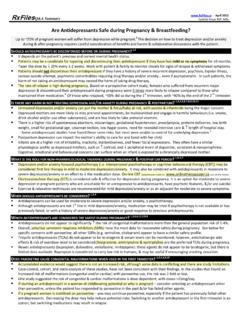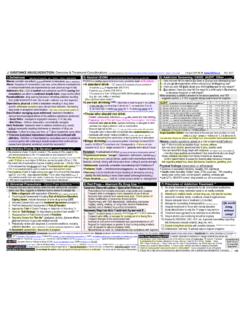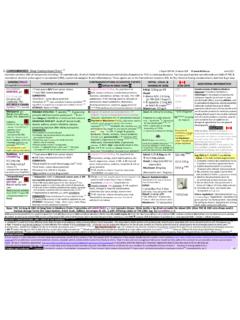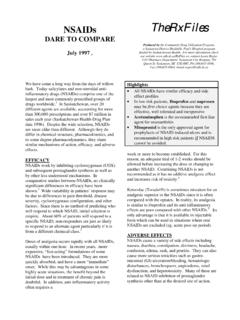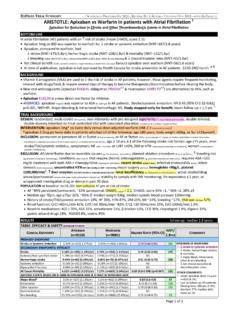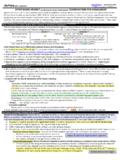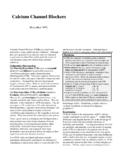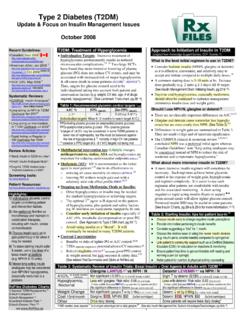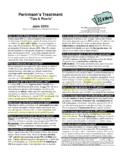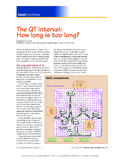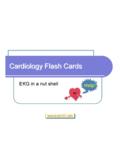Transcription of QT PROLONGATION and TORSADES DE POINTES: DRUGS …
1 The Rx Files: Q&A SummaryMar, 2005S. Downey BSP, B. Jensen BSP, BSP, BAPROMOTING OPTIMAL DRUG PROLONGATION and TORSADES DE pointes : DRUGS and SUDDEN DEATHWhat is TORSADES de pointes (TdP)? TdP or twisting of the points refers to a polymorphic ventricular tachycardia It is associated with a prolonged QTc interval and bradycardia; patients may also report shortness of breath or syncope TdP is thought to be caused by early after-depolarizations during prolonged repolarization1 It is often self-limiting but may be potentially fatal, sometimes leading to syncope and/or sudden death TdP can be either 1 (congenital) or 2 (acquired) due to metabolic disturbances, medical conditions, or most commonly, DRUGS 1,10 Recent USA black box FDA WARNINGS due to QT PROLONGATION : amiodarone, cisapride, droperidol, itraconazole & thioridazine 13 Recent drug FDA REMOVALS due to QT PROLONGATION : astemizole (Hismanal), grepafloxacin (Raxar) & terfenadine (Seldane).
2 13 Who is at risk?1-6,14 The multiple hit theory suggests that a culmination of several factors is required to induce TdP 2 Generally, these factors promote early after-depolarizations or PROLONGATION of the action potential 1 Table 1: Risk Factors for QT interval PROLONGATION and TdP 1-6 * greatest significanceCardiac Bradycardia < 50 bpm*Cardiomyopathy: Heart failure Left ventricular hypertrophy *Myocardial infarction*Congenital long QT interval (incidence ~ 1/5000)8 Hypertension Ischemic heart diseaseMetabolicAltered nutritional status: Alcoholism Anorexia, starvationDiabetesElectrolyte disturbances: Hypokalemia Hypomagnesemia HypocalcemiaHypoglycemiaHypothermiaOther *Age - risk with age Cerebrovascular disease*Female sex sex hormonesregulate channel expression Hypothyroidism Obesity Pituitary insufficiency Poisoning arsenic, organophosphates, nerve gas Renal disease * DRUGS (see Table 2)Which DRUGS are implicated?
3 Many DRUGS from a variety of therapeutic classes have been associated with QT interval PROLONGATION and/or TdP (see table) All of these DRUGS have in common their ability to block the I kr potassium channel; this results in increased repolarization time and a prolonged QT interval (beginning of QRS complex to end of T wave) on Inward Na+ and Ca+ influx channels may also be affected 8 PROLONGATION of the QT interval is thought to be dose-related and can occur within therapeutic range for some agents (eg amiodarone) but only at supra-therapeutic concentrations for others (eg. clarithromycin) Effects of different DRUGS can be additive Since many of these DRUGS are also metabolized by the cytochrome P450 system, serious and sometimes lethal drug interactions can occur when combined with DRUGS which inhibit or compete for binding to these isoenzymes (see table)How to avoid trouble: 2,6 Identify those at risk (Table 1); be aware however, that individuals vulnerability can vary greatly due to a complexity of genetic and environmental factors which are not completely understood For patients with major or multiple risk factors, obtain a baseline ECG and determine the QTc interval (corrected for heart rate equation described elsewhere7) Short 2 QTc < sec.
4 VERY LOW RISK-may not require ECG monitoring after initiating a QT-prolonging agent but should have if additional risk factors develop or if a drug interaction is likely Intermediate QTc sec ..LOW - MODERATE RISK- repeat ECG after initiating any QT prolonging agent, again at steady state, weekly for 1st month, then q6months and when any other QT prolonging agent is added or if a drug interaction is likely- if QTc > sec, reduce dosages or avoid these agents and use alternatives Prolonged QTc > sec ..MODERATE - HIGH RISK- repeat ECG after initiating any QT prolonging agent, again at steady state, weekly for 1st month, then q6months and when any other QT prolonging agent is added or if a drug interaction is likely- if QTc > sec avoid these agents and use alternatives- regular monitoring of serum K+ and Mg+ also advisedRule of thumb 8: A QTc change of < 10msec is acceptable as long as there are no other significant risk factors; If the QTc change is >10msec, reduce dosage or eliminate the drug(s), monitor more Rx Files: Q&A SummaryMar, 2005S.
5 Downey BSP, B. Jensen BSP, BSP, BAPROMOTING OPTIMAL DRUG to treat TdP:Emergency: 9 Do not use standard antiarrhythmic agents Give magnesium sulphate 2 grams IV over 2 minutes. If ineffective, consider isoproterenol , dobutamine, or atropine IV Consider giving potassium if serum K+ is low; bicarbonate for TCP (phencyclidine) or quinidine poisoning Lidocaine & phenytoin have also been usedLater: Stop the offending agent Maintain normal K+ , Mg++ and HCO3_ Keep out of trouble as aboveTable 2: DRUGS which can prolong QT Interval 1,3,6,9,12,13,14 -see also Agents /PsychotropicsAnti-InfectiveAgentsMiscel laneousAgentsCytochrome P450 InhibitorsAnti-arrhythmics Amiodarone(low risk of TdPcompared to otherclass III agents such assotalol.)
6 Howeverpotential for DIs) Bepridil Bretylium Disopyramide Dofetilide Flecainide Ibutilide Procainamide Propafenone Quinidine SotalolDobutamineDopamineIsradipineMoexi pril/HCTZN icardipineNorepinephrine---------------- ----------ADHD agents Amphetamine Atomoxetine Dextroamphetamine MethylphenidateAntiemetics Dolasetron Domperidone Droperidol Granisetron OndansetronAnticonvulsants Felbamate Fosphenytoin LithiumAntipsychotics Clozapine Phenothiazines (PZs) Chlorpromazine Perphenazine Mesoridazine Thioridazine Butyrophenones Haloperidol Thioxanthines Pimozide Quetiapine Risperidone ZiprasidoneChloral HydrateSSRIs Fluoxetine Paroxetine SertralineSNRI VenlafaxineTCAs Amitriptyline Amoxapine Clomipramine Desipramine Doxepin Imipramine Maprotiline NortriptylineAntibiotics Cotrimoxazole Fluoroquinolones Gatifloxacin Gemifloxacin Levofloxacin Moxifloxacin Ofloxacin Macrolides Azrithromycin Clarithromycin Erythromycin 11 RoxithromycinAzole Antifungals Fluconazole Itraconazole Ketoconazole VoriconazoleAntimalarials Chloroquine Halofantrine Mefloquine QuininePentamidineAlfuzosinAmantidineArs enic trioxideCisapride(Special
7 Access)CocaineCyclosporinFoscarnetHydrox yzineIndapamideMethadoneMidodrineOctreot idePhenylephrineProbucolPseudoephedrineR itodrineTacrolimusTamoxifenTizanidineTri ptans(Recently off QT list)VardenafilAntihistamines Diphenhydramine Clemastine Loratidine (proposed but no reports) Withdrawn: Astemizole & terfenadineAppetite suppressant Ephedrine Fenfluramine Phentermine SibutramineBronchodilators Epinephrine Isoproterenol Levalbuterol Metaproterenol Salbutamol/albuterol Salmeterol TerbutalineCYP3A4amiodaroneAzole antifungals: Fluconazole Itraconazole KetoconazoleCalcium channel blocker: Diltiazem VerapamilCimetidineCiprofloxacinGrapefru it juiceHIV: protease inhibitorsMacrolides: Erythromycin Clarithromycin Troleandomycin (not with Azithromycin)MethadoneSSRI's: Fluvoxamine Norfluoxetine Nefazodone ParoxetineCYP2D6 Beta Blockers (BBs)HaloperidolPhenothiazinesQuinidineS SRIs (not interact with citalopram)TerbinafineTCAs-------------- ------------less significantCYP1A2 FluoroquinolonesFluvoxamineGrapefruit juiceAVOID COMBINATIONS of PHENOTHIAZINES with TCAs, BETA BLOCKERS, and ANTICONVULSANTSSome DRUGS (eg.
8 Erythromycin & amiodarone) prolong the QT Interval AND act as inhibitors to potentially increase levels or QT effects of concomitant significance (well-documented) REGULAR=low-moderate significance (fewer case reports) ITALIC=minor significance (theoretical, few if any case reports)References:1. Wolbrette D. DRUGS that cause TdP & increase the risk of sudden cardiac death. Curr Card Reports 2004; 6: Wojciech Z & Lin D. Antipsychotic DRUGS and QT interval PROLONGATION . Psychiatr Q 2003; 74(3): Taylor D. Antipsychotics and QT PROLONGATION . Acta Psychiatr Scand 2003;107 Vieweg W. New generation antipsychotic DRUGS abd QTc interval PROLONGATION . Prim Care Companion J Clin Psychiatry 2003;5 (5) Roden D. Drug-induced PROLONGATION of the QT interval.
9 N Engl J Med 2004; 350: Crouch M et al. Clinical relevance & management of drug-related QT interval PROLONGATION . Pharmacotherapy 2003; 23(7) Witchel H et al. Psychotropic DRUGS , cardiac arrhythmia, & sudden death. J Clin Psychopharmacol 2003; 23(1) Brown et al. Cardiovascular effects of anti-psychotics. Clin Pharmacokinet 2004; 43(1): 38-569. Gowda RM, et al. Torsade de pointes : the clinical considerations. Int J Cardiol. 2004;96:110. Sudden Arrhythmia Death Syndromes Foundation The long QT syndrome. SADS Foundation (Cardiac Arrhythmia Reasearch & Education Foundation )11. Ray WA, et al. Oral erythromycin & the risk of sudden death from cardiac causes. N Engl J Med. 2004 Sep 9;351(11) Liu BA, Juurlink DN. DRUGS and the QT interval - caveat doctor.
10 N Engl J Med. 2004 Sep 9;351(11) Woeffel JA. Drug-Induced Long QT Interval & Sudden Cardiac Death. Pharmacist's Letter Nov 2004;20:20111114. Al-Khatib SM, LaPointe NM, Kramer JM, Califf RM. What clinicians should know about the QT interval. JAMA. 2003 Apr 23-30;289(16):2120-7. Review. Erratum in: JAMA. 2003 Sep 10;290(10):1318.
